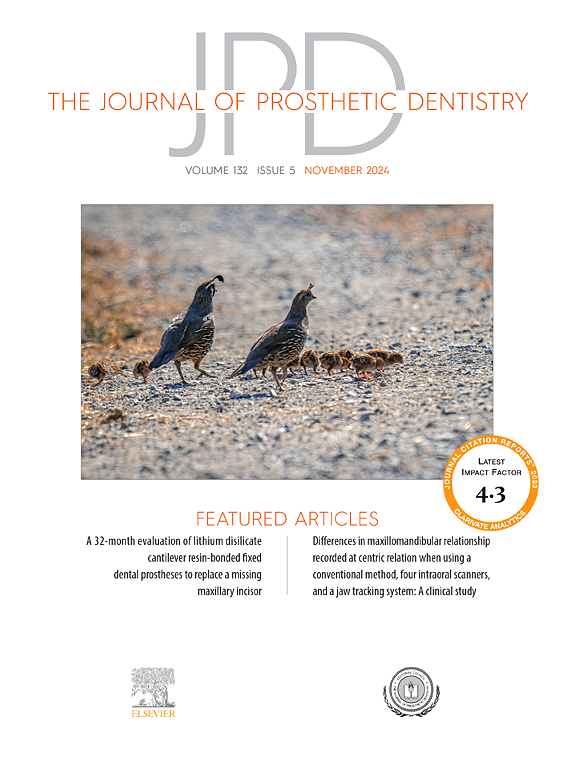Complete arch implant scans with standard scan bodies versus scannable healing abutments on scanning accuracy, scanning time, and number of photograms: A comparative clinical study
IF 4.8
2区 医学
Q1 DENTISTRY, ORAL SURGERY & MEDICINE
引用次数: 0
Abstract
Statement of problem
Digital scans for complete arch implant fixed dental prostheses are typically performed using implant scan bodies (ISBs). Scannable healing abutments may be an alternative to ISBs. However, evidence on the accuracy, scanning time, and number of photograms of digital scans using scannable healing abutments remains uncertain.
Purpose
The purpose of this clinical study was to evaluate the scanning accuracy, scanning time, and number of photograms of scannable healing abutments of several heights in comparison with standard ISBs.
Material and methods
A reference stone cast was obtained from a patient with 7 maxillary implants from a splinted open-tray conventional impression. It was digitized by using a laboratory scanner (E4 Scanner). A milled titanium bar was manufactured, and passive fit was evaluated clinically and radiographically. Three groups (n=15) were determined based on the devices used during the intraoral scanning procedure (TRIOS 4): standard ISB (Scanbody 2800) (Group STD), 5-mm height scannable healing abutment (TissueShaper 5 mm) (Group TS5), and 7-mm height scannable healing abutment (TissueShaper 7 mm) (Group TS7). The implant abutment discrepancy between the platform of the abutments of the digitized reference cast and the intraoral scans from the different groups were calculated. Maximum deviation (highest value of misfit per scan) and overall deviations (mean of all the deviations of the scan) were considered. The scanning time and number of photograms were registered. The 1-way ANOVA and Tukey tests were used to analyze trueness. The Levene test was used to analyze the precision. ANOVA and the post hoc Tukey test were used to evaluate the scanning time and numbers of photograms (α=.05).
Results
Significant trueness differences were found in the overall and maximum misfit among the groups (P<.05). Significant precision discrepancies were revealed in the maximum misfit (P<.05) but not in the overall misfit (P=.56). The highest deviations were in the STD group (overall: 94 ±6 µm; maximum misfit: 172 ±24 µm), followed by TS5 (overall: 72 ±10 µm; maximum misfit: 112 ±15 µm) and TS7 (overall: 63 ±9 µm; maximum misfit: 91 ±20 µm). Significant differences in scanning time and number of photograms were found between the STD group and both the TS5 and TS7 groups (P<.01). The longest scanning time (129.9 ±16.7 s) and highest number of photograms (1322 ±150 photograms) were in the STD group in comparison with TS5 (71.7 ±10.8 s; 805 ±104 photograms) and TS7 (77.3 ±0.9 s; 764 ±119 photograms).
Conclusions
The tested scannable healing abutments improved the accuracy and decreased the scanning time and number of photograms in complete arch implant digital scans recorded by using the IOS assessed.
标准扫描体与可扫描愈合基台的全弓种植体扫描在扫描精度、扫描时间和照片数量上的比较临床研究。
问题说明:全弓种植体固定义齿的数字扫描通常使用种植体扫描体(ISBs)进行。可扫描修复基台可能是isb的替代选择。然而,关于使用可扫描愈合基台的数字扫描的准确性、扫描时间和照片数量的证据仍然不确定。目的:本临床研究的目的是评估不同高度可扫描愈合基台的扫描精度、扫描时间和照片数量,并与标准isb进行比较。材料和方法:我们从一名7颗上颌种植体的患者身上获得了一个参考石模型,该模型来自于夹板开盘常规印模。使用实验室扫描仪(E4扫描仪)对其进行数字化处理。制作了一根磨钛棒,并进行了临床和放射学评估。根据口腔内扫描过程中使用的设备(TRIOS 4)确定三组(n=15):标准ISB (Scanbody 2800) (STD组),5毫米高度可扫描愈合基台(TissueShaper 5 mm) (TS5组)和7毫米高度可扫描愈合基台(TissueShaper 7 mm) (TS7组)。计算数字化参考铸型的基台平台与不同组的口内扫描结果的种植体基台差异。考虑最大偏差(每次扫描误差的最大值)和总体偏差(所有扫描偏差的平均值)。记录扫描时间和照片数量。采用单因素方差分析和Tukey检验分析真实度。采用Levene检验对其精密度进行了分析。采用方差分析和事后Tukey检验评价扫描时间和照片数量(α= 0.05)。结果:两组间在总体和最大不匹配度上存在显著性差异(p)。结论:采用评估的IOS,所测试的可扫描愈合基台提高了全弓种植体数字扫描的准确性,减少了扫描时间和照片数量。
本文章由计算机程序翻译,如有差异,请以英文原文为准。
求助全文
约1分钟内获得全文
求助全文
来源期刊

Journal of Prosthetic Dentistry
医学-牙科与口腔外科
CiteScore
7.00
自引率
13.00%
发文量
599
审稿时长
69 days
期刊介绍:
The Journal of Prosthetic Dentistry is the leading professional journal devoted exclusively to prosthetic and restorative dentistry. The Journal is the official publication for 24 leading U.S. international prosthodontic organizations. The monthly publication features timely, original peer-reviewed articles on the newest techniques, dental materials, and research findings. The Journal serves prosthodontists and dentists in advanced practice, and features color photos that illustrate many step-by-step procedures. The Journal of Prosthetic Dentistry is included in Index Medicus and CINAHL.
 求助内容:
求助内容: 应助结果提醒方式:
应助结果提醒方式:


